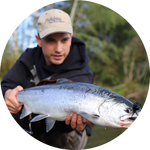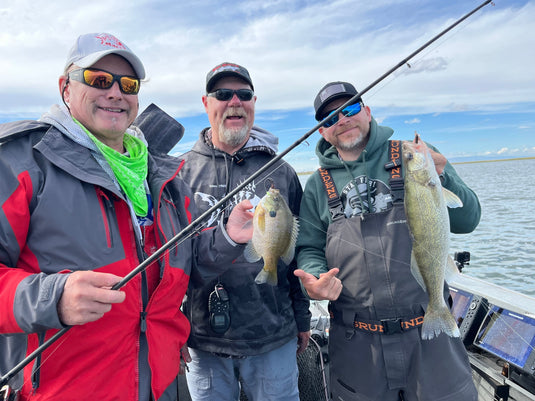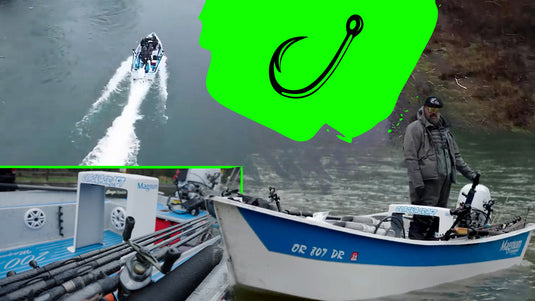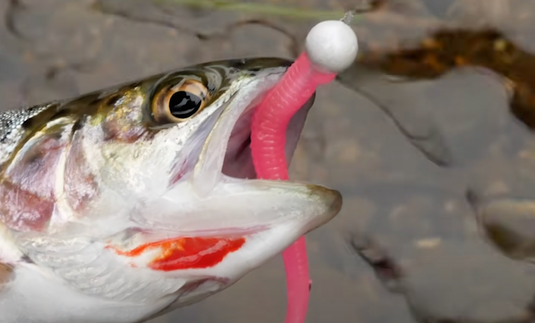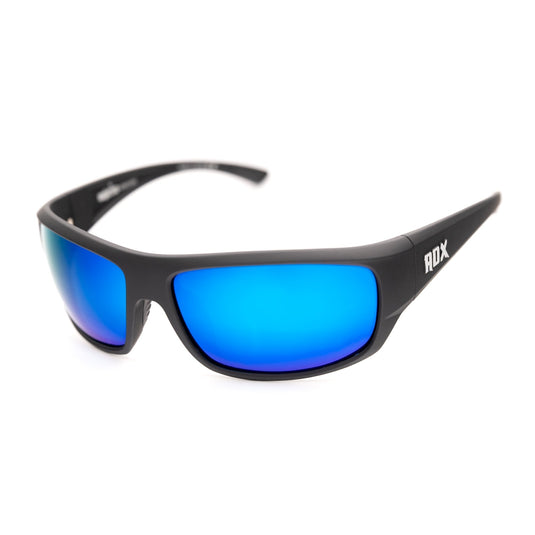The Very Best Fishing Line Is?

It’s as simple as picking between braid and monofilament, right? Well, not quite. In recent decades fishing line technology has been leapfrogging itself and with the present varieties of line and their specific uses available, it might pay you to make your spool-up decisions armed with a little more information.
In a more primitive day, fisherman could only use gut, hair, silk or string to connect hook to rod. {“Look! Oog have big fish on line! Me stand there too!” – Yes, competition began early…..}
Then came the advent of that space-age material, nylon monofilament. Clear, smooth, strong and relatively small in diameter, mono revolutionized the quality and length of lines that could be wound onto a reel. Fishermen could fool fish in clear water, cast further, troll deeper, fight heavier fish over longer distances and enjoy small, reliable knots on their hooks.
This breakthrough also forced leaps forward in fishing reel technology. No longer were reels just storage devices, and concepts like casting distances, fish-fighting drags, line capacities, gear ratios and specialized features made fishing reel innovations skyrocket in importance. None of the reel features we have discussed in previous articles would be available to us now, without the blessing of modern fishing lines.
Monofilament itself has improved in leaps and bounds. Line diameters have been reduced, knot-strength improved, visibility (or invisibility) enhanced using different colors or properties, and overall consistent quality has vastly improved. These are not the monos of decades ago and they are dependable lines.
Some new lines, such as P-Line CX, incorporate ‘copolymer’ technology and offer a much smaller diameter at the same pound test or line strength. This means easier handling, smoother casting, less line ‘memory’ or coiling, less visibility to the fish and reduced planing of line. CX is also fluorocarbon coated, which also helps hide it from the wary fish’s eye.
I have caught many species of fish on P-Line CX Moss Green, including Salmon, Steelhead, Catfish, Largemouth, Smallmouth and Crappie, and the 20 pound test CX version remains one of my favorites for heavy cover Largemouth fishing.
When there is either moving water, or water pressure on line being drawn through water, it results in an often unwanted rise of baits or trolling riggings toward the surface. A smaller line diameter encounters less resistance and stays down deeper, hence one advantage of small-diameter line. The 20 pound CX diameter compares to 17 or even 15 pound test in other lines, so I can get more line on my spool in a bigger pound test, which is another valuable feature.
The relatively new copolymer lines are a real improvement on ordinary mono. The copolymerization process combines several nylon ‘monomers’ (A sort of hybrid of monofilaments) in a formula that produces a stronger, yet smaller line that reacts less to physical and chemical weakening. This also translates to good abrasion resistance.
I have fished with Silver Thread’s ‘Excalibur’ copolymer and had good success hauling in big Largemouths on it too. It is more expensive than some lines, but the quality is worth it. My brother, ‘Mr. Finesse,’ likes the clear Silver Thread copolymer for his subtle soft-plastics presentations. Other popular copolymer lines include Berkley Trilene Sensation, Suffix, Izorline and YoZuri (http://www.tacklewarehouse.com/catpage-FLCOPOLYMER.html). I have not fished them all, but I’ve had enthusiastic reports from other fishermen.
A related but high-tech departure from monofilament and copolymer is ‘flourocarbon.’ While it looks like mono, its chemical structure is quite different. It is made of extruded polyvinylidene fluoride, a material that is denser than mono and copolymer, and has a light refraction almost identical to water itself. This means that in its pure form, fish just can’t see it at all. It also absorbs less moisture, does not stretch as much, and is ‘harder’ on the outside than the above lines. Also, fluorocarbon sinks in water. Doesn’t take much imagination to think of some real advantages here, does it? Some earlier fluorocarbons were a little stiff, but most of them cast quite well. Most manufacturers have at least one fluorocarbon offering. Here is a helpful comparison of various fluorocarbons: http://www.tackletour.com/reviewfluorocarbontest.html
Even the best of the new monofilaments, flourocarbons and copolymers suffer from a tendency that many fishermen do not welcome…..Line stretch. Sometimes stretch is a good thing. I like knowing that my copolymer line will stretch a little at the hookset. Most of the time the distance from rod to bait is not that far, and I do not want to tear away a crankbait, topwater or other hardbait from a freight-training monster Bass. Also, at boatside where many fights are lost, and where there is only a short length of line under tension between you and your potential catch, do you want some cushioning when the fish shakes his head? I sure do!
But sometimes you can get too much of a good thing. Some of the older monos will stretch as much as 30% of length when the line is wet. Many monos have been reduced to 25% or even less than 10% stretch. Some stretch percentages are just too much. How far back can you sweep your rod in a hookset, and how long do you want it take before the hook point actually penetrates when a fish is biting? Before you pick one of these lines, take a good length of it and see if you like the amount of stretch. Find one that is acceptable to you.
A newer line that completely eliminates the stretch problem is a complete departure from either mono, flourocarbon or copolymer, called ‘braid.’ It is made by intertwining fibrous material, usually aramid, gel-spun polyethylene or Dacron, and weaving it into a very tough, very small-diameter line. A variation of braid is ‘fused’ line, actually braided fibers that have been fused into what appears and performs as one single strand.
Most braids have a wet-stretch of only 2 to 4 % or less. That means whatever happens at the tip of your rod is immediately happening at the hook, and vice versa. This can give you a tremendous advantage.
Braids are so small in diameter compared to mono and copolymer that line capacity on your reel is no longer a consideration. Braids are very light and have a tendency to float, making them the choice of many bobber and jig fishermen, especially in the high-vis form. There is virtually no line-memory or coiling, and braided line is also extremely long-lasting and tough. This can be a real problem for older rods with softer guides and tips, and for older reels with softer line rollers. Braid can saw right down into them. If you make the mistake of wrapping the line around your hand to yank it, it will cut through your hand too!
In the weight ranges I use for Bass, braid can actually be too small at times. I do not want to waste time on the water trying to get spider-like braid out of snap rings and other terminal tackle, wind knots from wispy lines and breezes are always unwelcome, and I do not want braid pulling down inside of itself on my spool when I put it under pressure. These are some of the drawbacks of smaller pound test braids. I know some fisherman who have resolved these problems and adapted well enough to be big fans of lighter braid, so it could be just my own preferences here.
On big water and in bigger sizes, I find braid to be superior in almost all respects. I have caught 8 ½ foot Sturgeon and big Spring Chinook Salmon on the Columbia River using braids. Sea Lions and other boaters and lines might be a worry, but not this line! Power Pro, Tuff Line, Berkley Spider Wire and Fireline, and P-Line Spectrex are all excellent braids, with only personal choice of color and ‘feel’ of the line itself being considerations. http://www.nextag.com/braided-fishing-line/search-html
Just a warning: Braid will work fine on the new low-profile bait-casting reels, in fact that is one of its strong suits. But remember the power and strength of this line! You can literally deform, bend or collapse a small, super-light, high-quality, floating spool by applying too much force with braided line. Also, line rollers on spinning reels and other reel parts can be susceptible to increased wear due to braid’s tough qualities. Choose your pound test accordingly and remember that your reel, no matter how high-end and well-machined, is not indestructible! Yes, braid really is that strong.
Now with all this information and real-time fishing tests, which line do I choose as my all-time favorite? The winner is . . . You guessed it. It really depends on what I want the line to do in a given situation.
Do I want a great, invisible, quick-sinking, low-stretch, high-sensitivity line for finessing big smart Bass with a subtle drop-shot rig? Then I should probably pick fluorocarbon.
Do I want to jab the hook in deep and cut my way out of tangles of cover with tough, powerful line when fighting a monster Bass that attacked my jig-and-pig? Then it’s time for some braid.
Do I want something that will load up and stretch a little bit on my long-distance casts, allow my crankbaits and spinnerbaits to stay at the desired depth, allow the fish to get a good pull going on my topwaters before I set the hook, and still be a relatively invisible line? Then I’m going with a small-diameter copolymer.
You will undoubtedly find your own favorites for various kinds of fishing.
I for one am very happy that line technology has come so far and allows so many excellent choices for just the right situations.
We’ll talk about which baits to tie these excellent lines onto when the May article comes out. Keep your wet side down and your dry side up, and give a few good, eye-crossing hooksets for me till then!
Fanatically Yours,
Bassmaster Bob
P.S. Please remember that all lines actually last a long time out in nature. They can prove to be cruel death-traps to birds and critters. I often return from fishing trips with someone else’s line wadded up in my pockets to discard later. It’s smart to take good care of your favorite fishing holes!
Please check out our sponsor- http://www.reellifestyle.com/



